Terra Nova National Park is a beautiful, quiet,
undeveloped park. The sites in our unserviced section of the campground were
huge and largely open to the sky
 |
A huge site- almost 90ft.
|
notwithstanding the park’s description as full
shade. The weather was drizzle and rain,
so we drove into Glovertown to do some shopping. In spite of the weather, we
managed a couple of short hikes and drives, one to the highest point in the
park.
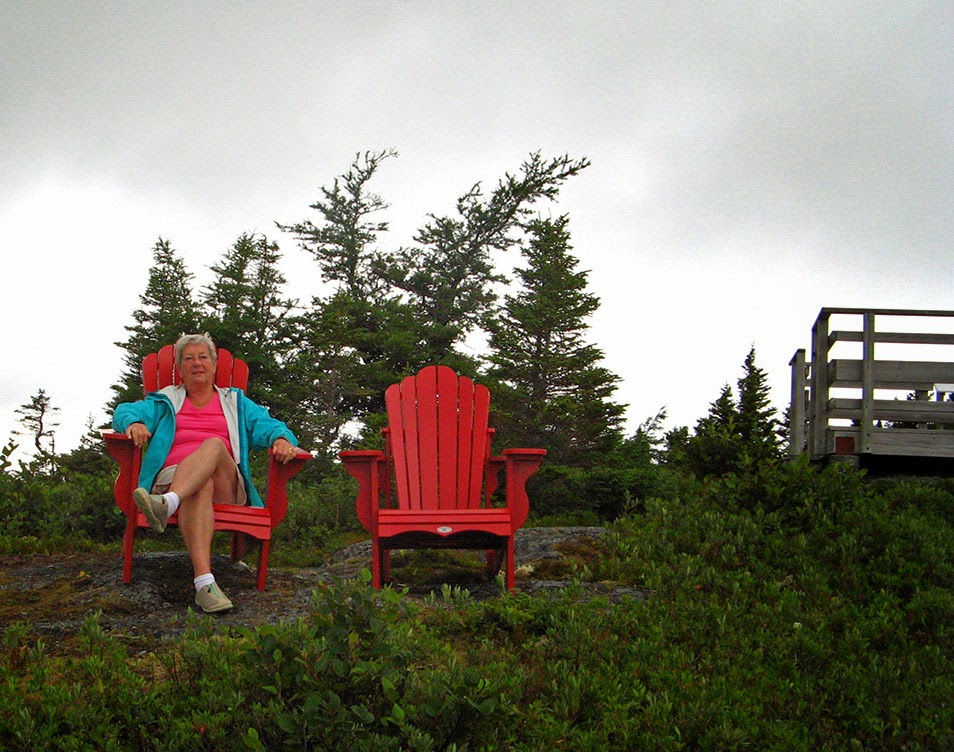 |
A rest when we got to the top- note red chairs in the National Park
|
The view was breathtaking- and I imagine even better without fog and
drizzle!
 |
A beautiful site
|
Daisies and lupins were gone, but fireweed was beautiful, in fields
and beside the roads.
We drove to the Bonavista Peninsula, and stayed in
Elliston. We were warned not to take the first road into Elliston. However,
when we came to the exit, there was no indication that there was another exit,
so we figured we had better take it. The road in was the worst road we have
ever driven, there were more potholes than road. The sign at the beginning
should have given us a clue.
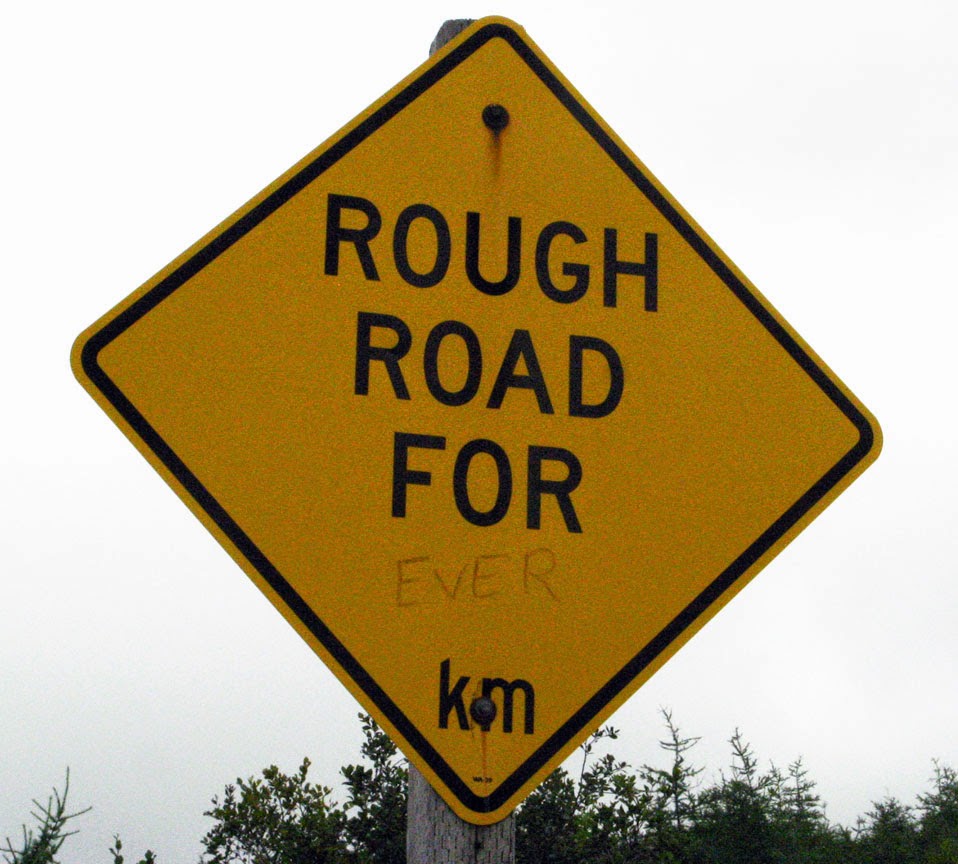 |
For "EVER"...
|
We have now
found our benchmark – this rates a 10 and every bad road will henceforth be
rated against it.
The campsite is a funky little park, part of Elliston’s
Municipal Park right beside Sandy Cove Beach. There is no cell coverage and no
internet. We had electricity and water, but with a boil water advisory as is
common in small campgrounds in Newfoundland (the water isn’t necessarily
tainted, it just hasn’t been tested). There are sites in 2 rows for about
sixteen RV’s and a couple for tents at the end.
 |
Our site, with Sandy Cove in the background
|
Apparently during their Puffin
Festival there are a hundred or so RV’s and campers, and cars everywhere! There
is no dump station, so you have to drive into Bona Vista to the first gas
station. The radio was only AM, so we couldn’t turn on any lights on the same
circuit as the radio, or we got very loud annoying interference.
Elliston is a small fishing town,
 |
Elliston
|
like most coastal towns
in Newfoundland, once a thriving. It was a sealing town as well and houses Home from The Sea, the John C. Crosbie
Sealers’ Interpretation Centre, where through artifacts, art and multimedia,
you learn the history of the sealer’s world. It also has a Sealers Memorial
Statue
 |
Father and son
|
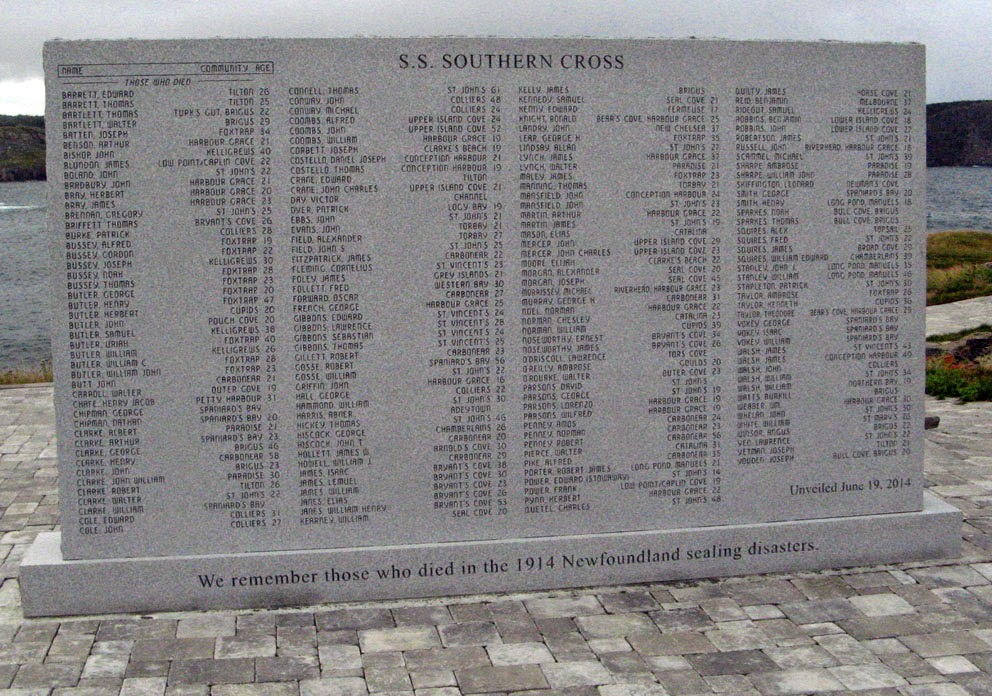 |
Names are on both sides of the monument
|
and Monument commemorating all those who perished on the ice, as well as
the survivors, in the 1914 SS.Newfoundland
sealing disaster and those who were lost in the sinking of the Southern Cross sealing ship in the same
storm.
It really has two other claims to fame, however. It is
the ‘Root Cellar Capital of the World’, having more than 130 root cellars in
use, the oldest being built in 1839.
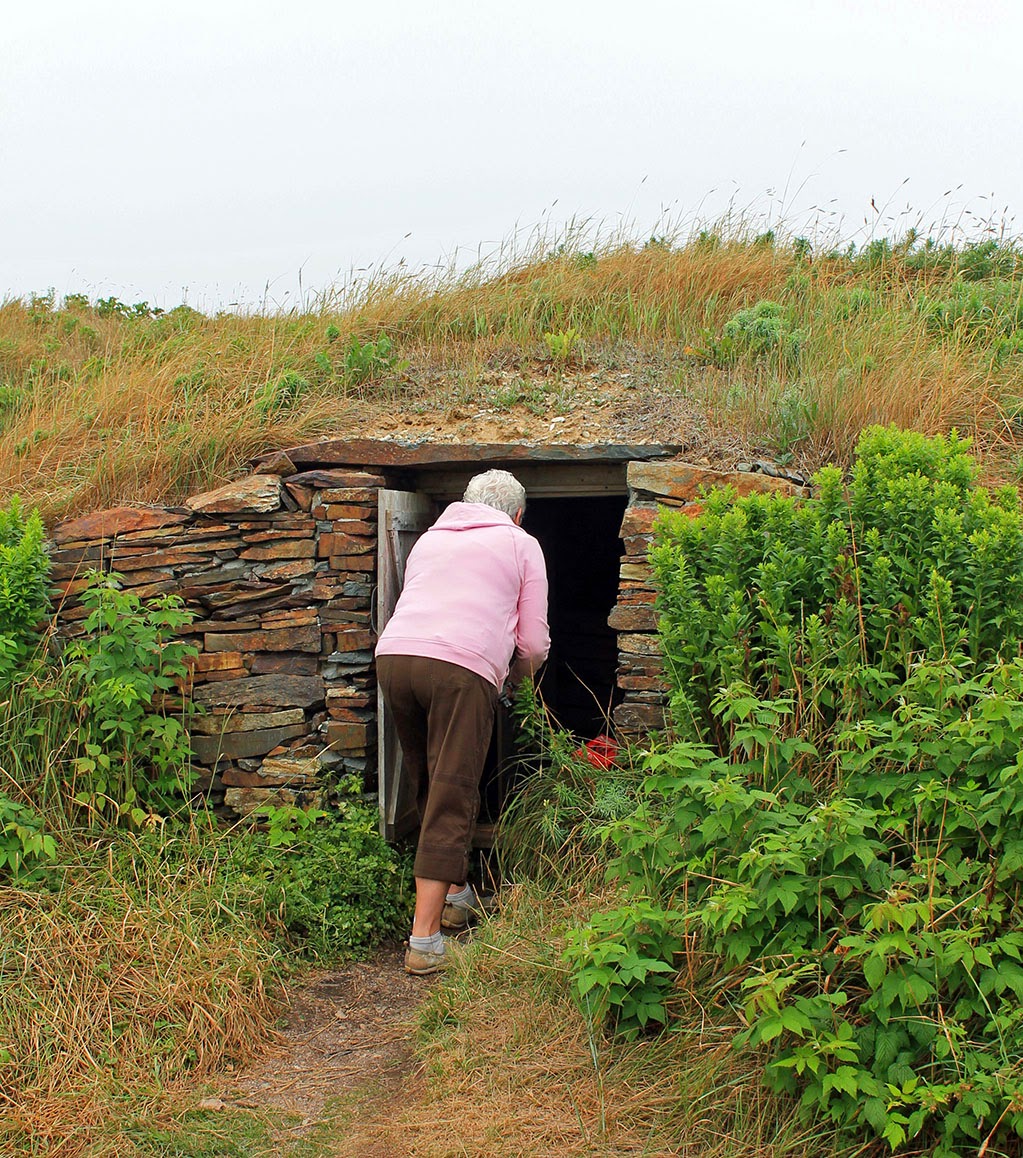 |
There is quite a bit of room, I was surprised
|
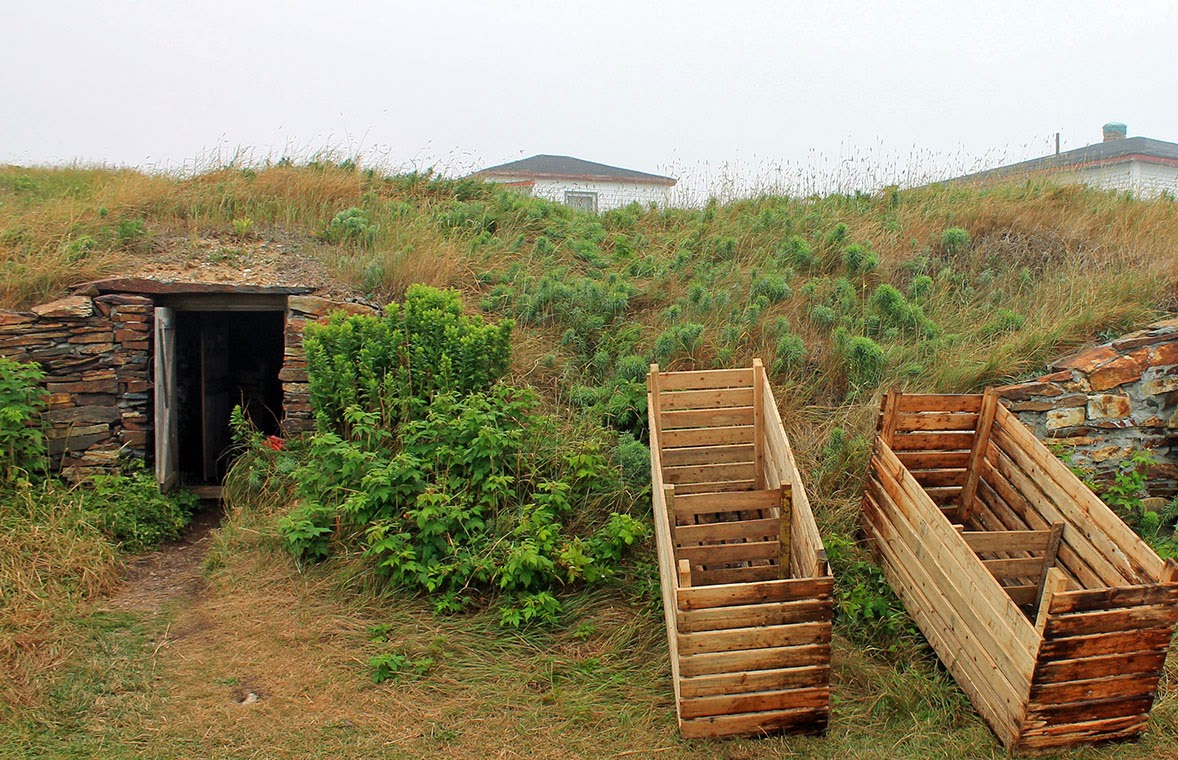 |
The boxes to store vegetables really do fit
|
 |
The boxes do fit in the Cellar
|
Mostly potatoes, turnip, carrots and
cabbage [usually pickled] were stored in the cellars, but meat fish and dairy
could be stored for shorter periods, as a well-built root cellar stayed dry and
kept a constant, cool temperature year-round.
It is also home to the world’s most accessible Atlantic
Puffin breeding site. You can walk out to a headland
 |
Walking out to the headland, along the cliffs
|
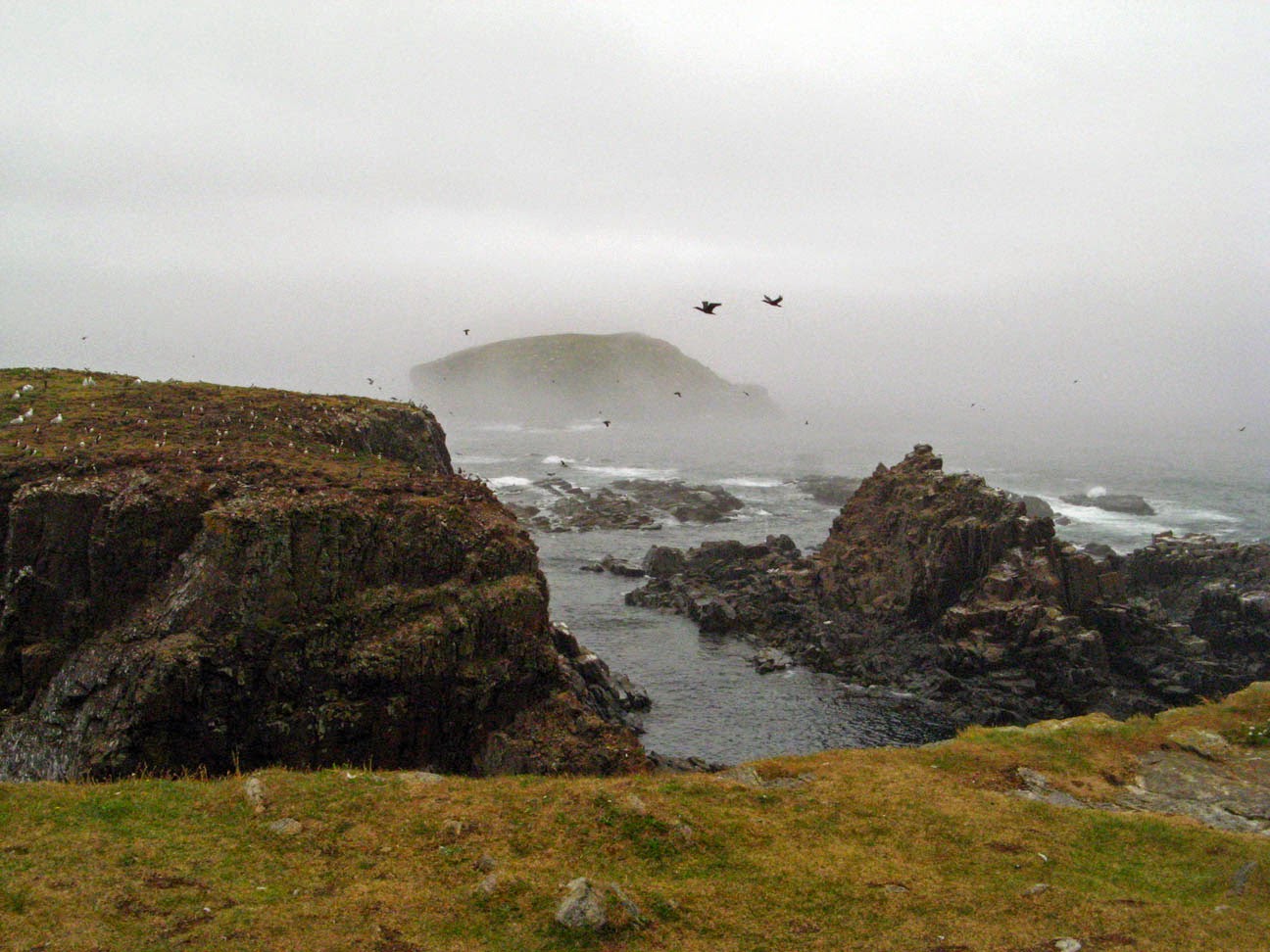 |
Looking across at the rock stacks as we rounded the headland to the Puffin Rock
|
and see a sea stack with
thousands of puffins up close, about 100 ft. away.
 |
See the burrows- taken from the main rock!
|
If there are not too many
people, and you stand or sit well back from the edge, the puffins will often
come to the headland within a few feet of you. You can see them and their young
clearly from the headland. John went out one rainy morning, and had puffins
close to him.
 |
John's picture taking in the rain and fog early one morning
|
We went out every day to see them, they are so amusing. They fly
right overhead, flapping their wings furiously. Their wings are hardly big
enough to propel them. John calls them “a triumph of effort over design”.
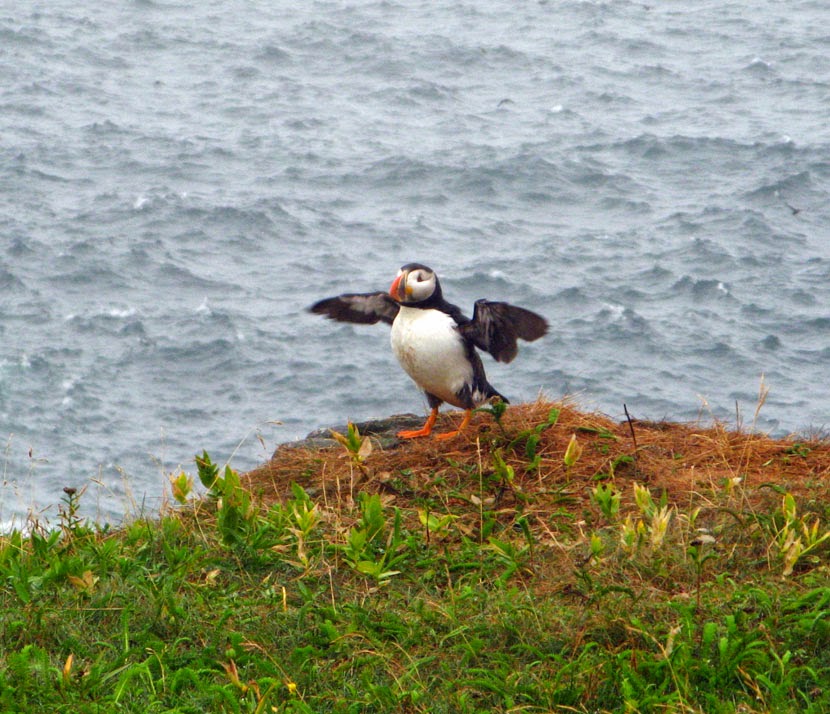 |
I think I can, I think I can, I know I can!
|
Think
of them as penguins who can fly as they use their wings as fins underwater
hunting for fish. They sort of crash land both on land and on water, leading
with their feet and landing on their butts.
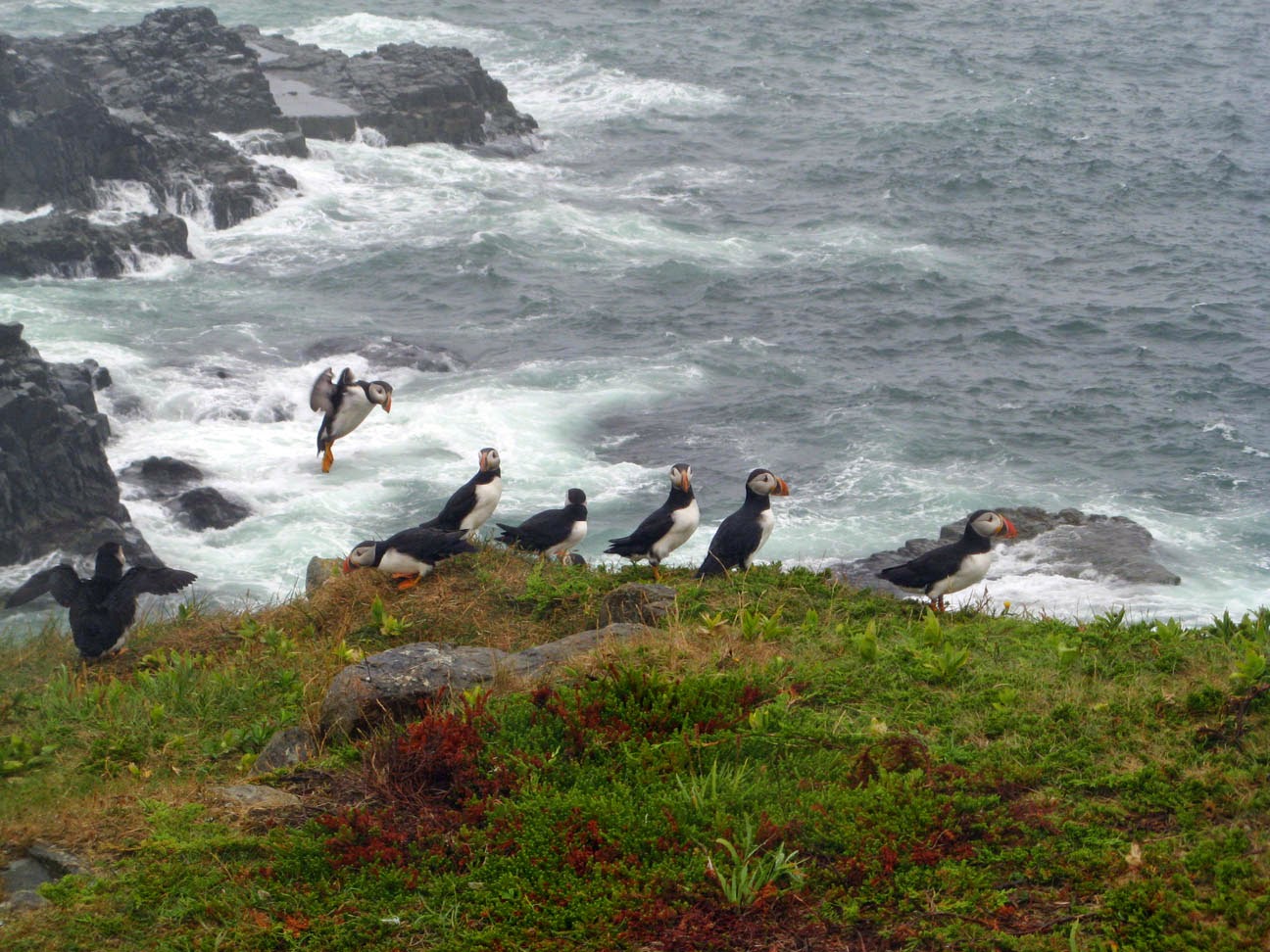 |
The one second from the left is coming in feet first
|
We learned that puffins mate for
life and lay one egg per year in a burrow. They spend the late fall and winter
at sea, returning in the spring to the same burrow.
One day we drove to the Puffin Venture
in Maberly, a
little town a kilometre up the coast. There is a little puffin souvenir store
and several history boards with interesting details of the area.
For example,
children were told that babies were dug out of the root cellars with a silver
shovel. One old-timer recalls her parents telling her that if it was foggy, she
was to be sure to turn her pockets inside out. Otherwise she would get lost. Jack-o-lanterns
were powerful spirits like a fairies, and when it was foggy, they would get
into your pockets, drag you off and make you get lost.
 |
Click on the pictures to enlarge them- then you can read the story
|
So when the fog cleared,
you wouldn’t know where you were.
We spent several days in Bonavista. There was so much to
see there. We first just drove around to get a sense where things were. A map
of the town looks as if someone threw spaghetti to create the roads. They go up
and down around hills, and stores, with little lane-like roads winding between
houses. We were particularly looking for a French Press for coffee. We
discovered that John’s was broken when we went to make morning coffee. We
stopped at a grocery store which had second floor with household goods. John
asked one of the women. She suggested he try “Drdls” he had her repeat it
several times, but each time it sounded the same. She then tried to show him
where it was. Although we had been in Newfoundland for over a month, he really
had no idea what she was saying (the Bonavista accent is very unique). So we
set off, but without any luck that night. We came back the next day to look
again, driving around streets looking for something like “Drdls”. I finally
spotted a Home Hardware store, and we decided to try there. When we looked up
as we parked, we saw the name of the store, “Durdells Home Hardware”. Apparently no one calls it just ‘Home
Hardware’!
We also toured some of the Ryan Premises,
 |
The Mercantile
|
which commemorate five centuries of commercial
fishing. It is a 19th century saltfish mercantile complex,
consisting of five buildings. It is a National Historic site, so we were able
to us our Parks Canada Discovery Pass. We took parts of two days to see all the
buildings. The largest exhibit is a multimedia, comprehensive explanation of
the history of cod fishing and the processes involved from catching the cod fish,
landing at the fish stages, heading, gutting [keeping the liver to be rendered
for cod-liver oil], splitting and removing the backbone, salting, washing and
drying on flakes
 |
A Fish Flake for drying the cod
|
or large platforms made of thin logs where fish are laid out.
French fishermen preferred to dry cod on pebbled beaches instead of flakes.
There were also a representation of the office and a mercantile or company
store. Included as well are the Bona Vista Museum, Life and Work in a Fishing
Community with hundreds of artifacts from the local community, rotating
exhibits of local artwork and a gift shop with locally-produced souvenirs,
crafts and clothes for sale. Across the road is the Proprietor’s house.
 |
From across the street
|
%2B9th.JPG) |
The front hall...
|
Most of the furniture is original, and would
have been purchased by James Ryan from England in the 1880’s.
Several people had recommended a restaurant called the Bonavista Social Club. We got directions
from a girl at the Visitors’ Centre and set off. We drove and drove. As we came
up to Newman’s Cove, where the road ran right beside the ocean. I spotted a
whale. We quickly pulled off and watched several Minke whales swim back and
forth quite close to the shore.
Several kilometres further on we saw a small
sign for the restaurant, Driving down the road, we came to a Y, and saw a small
faint sign on the side of a house. Finally we arrived. It was certainly worth
the drive.
 |
A wonderful restaurant, the Bonavista Social Club
|
 |
Looking up the road from the Bonavista Social Club
|
It is a family-run restaurant, which makes their own bread, desserts
and pizza dough, and grows their own vegetables and herbs. They make the best
pizza we had had in a very long time, and wonderful bread. They also had a cod
dinner which looked, and was reported to be, delicious. We each had a small
pizza. In retrospect, we could have split one, as we took some home for the
next day. On the way back there were five Minke whales again in Newman Cove
(two less than a hundred feet from shore).
 |
Two whales just swimming back and forth
|
They were just lazily swimming and
doing rolls - just showing off we think.
Another day we found another small restaurant called Neil’s Yard.
.JPG) |
Neil's Yard, and the building beside it were part of the Mockbeggar Plantation
|
Their specialty is crepes,
both savory and sweet, and European style cappuccinos and lattes. They also
have paninis and wonderful home-made desserts. The menu is limited, but
everything is delicious. We had dessert crepes the first time, and paninis, home-made
cheesecake and rhubarb-strawberry crumble the second time. We used their free
wifi while we were waiting. Neil’s rule is that the computers must be put away
while you are enjoying the food.
The Matthew Legacy
site, up the road,
 |
The Mathew Legacy building in the harbour
|
houses a full scale replica of The Matthew the ship which first brought John Cabot and his crew to
Bonavista in 1497.
The first room tells the story of sailing and trading life
in 15th Century from the viewpoint of a young apprentice on trading
ships, who becomes friends with Giovanni Caboto, and later sails with him
across the uncharted Atlantic.
We
were looking for the dump station, and our friendly guides at the Visitors'
Centre told us it was out on the road to the lighthouse. We drove out but
couldn't find it. However we saw a group of RV’s boondocking by
the road. We stopped to ask them, and ended up joining them for a glass of
wine, good conversation and snacks. We found out where the dump station was,
but decided to carry on to see the Cape Bonavista lighthouse, a Provincial
Historical Site.
This is mid-1800's lighthouse, with the house surrounding the
lighthouse for easy access to the light. The house section is furnished and
decorated circa 1870. The original light came from Inchcape Rock in Scotland.
 |
The original lights
|
In 1962, it was automated and placed on an exterior street tower.
There
is a statue of John Cabot out at Cape Bonavista. It is supposedly on the site
where he first landed.
On
the way out we saw a sign for Dungeon
Provincial Park. We drove in across a large open area inhabited by free
running cows
.JPG) |
This little guy wouldn't move!
|
and sheep and found a parking lot and large wooden platform with
story boards. It was amazing - looking over a cliff we spotted arches carved in
the rock at the edge of the bay.
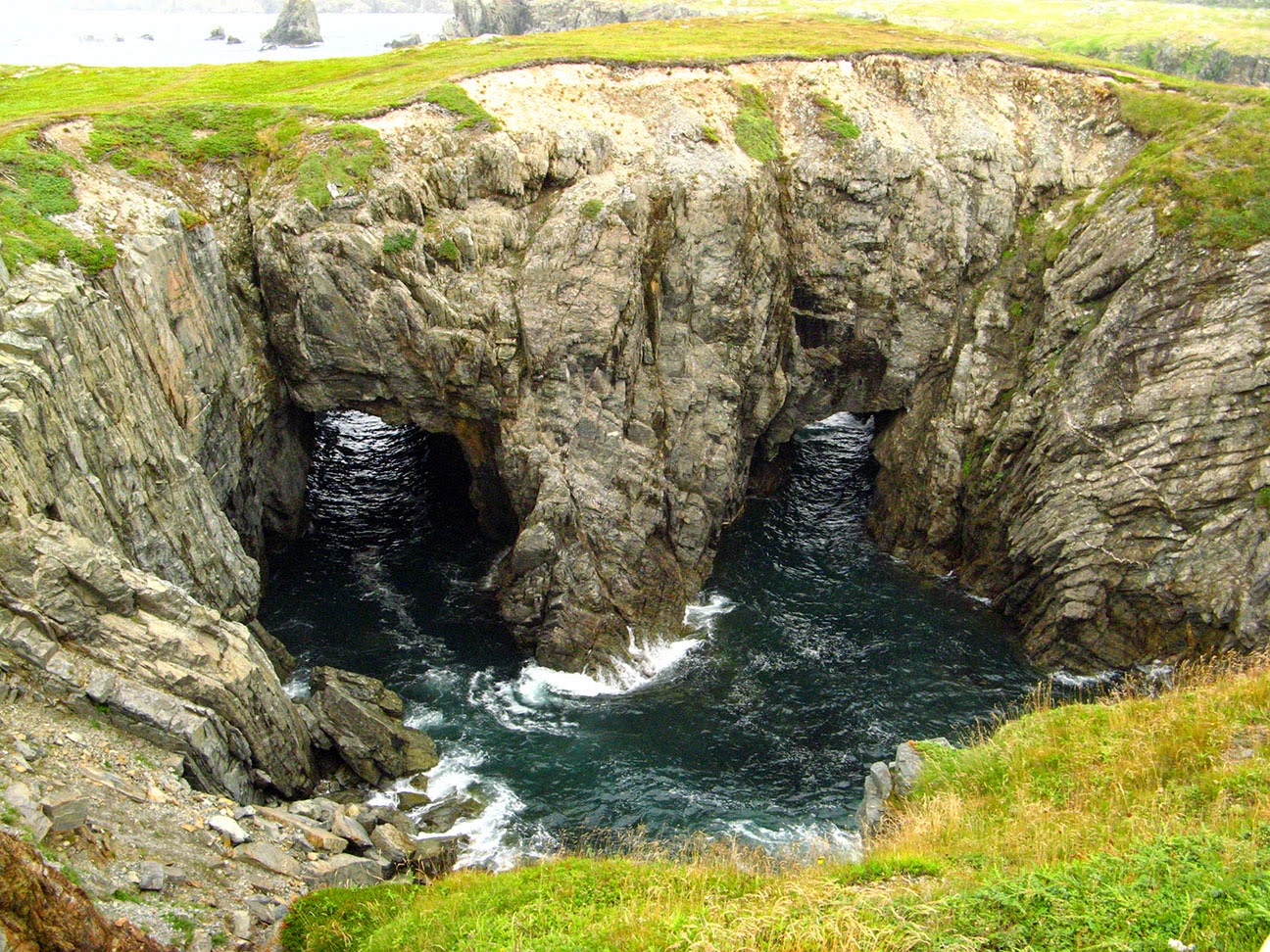.JPG) |
It is really cool to see the sea rushing in with each wave
|
Apparently this was a twin-entranced sea cave,
but as the water eroded the rock, eventually the roof fell in. It is about 50
ft. (2014 Vacation Guide says 15 metres) deep and about 300ft across. From the
ocean side it is a circular opening in the cliff with two seaward channels
where the ocean rushes in. The tide has created a natural sand beach in the
cave. On the way back to the main road, we spotted a group of horses down by a
pool,
roaming on the cliffs down by the ocean.
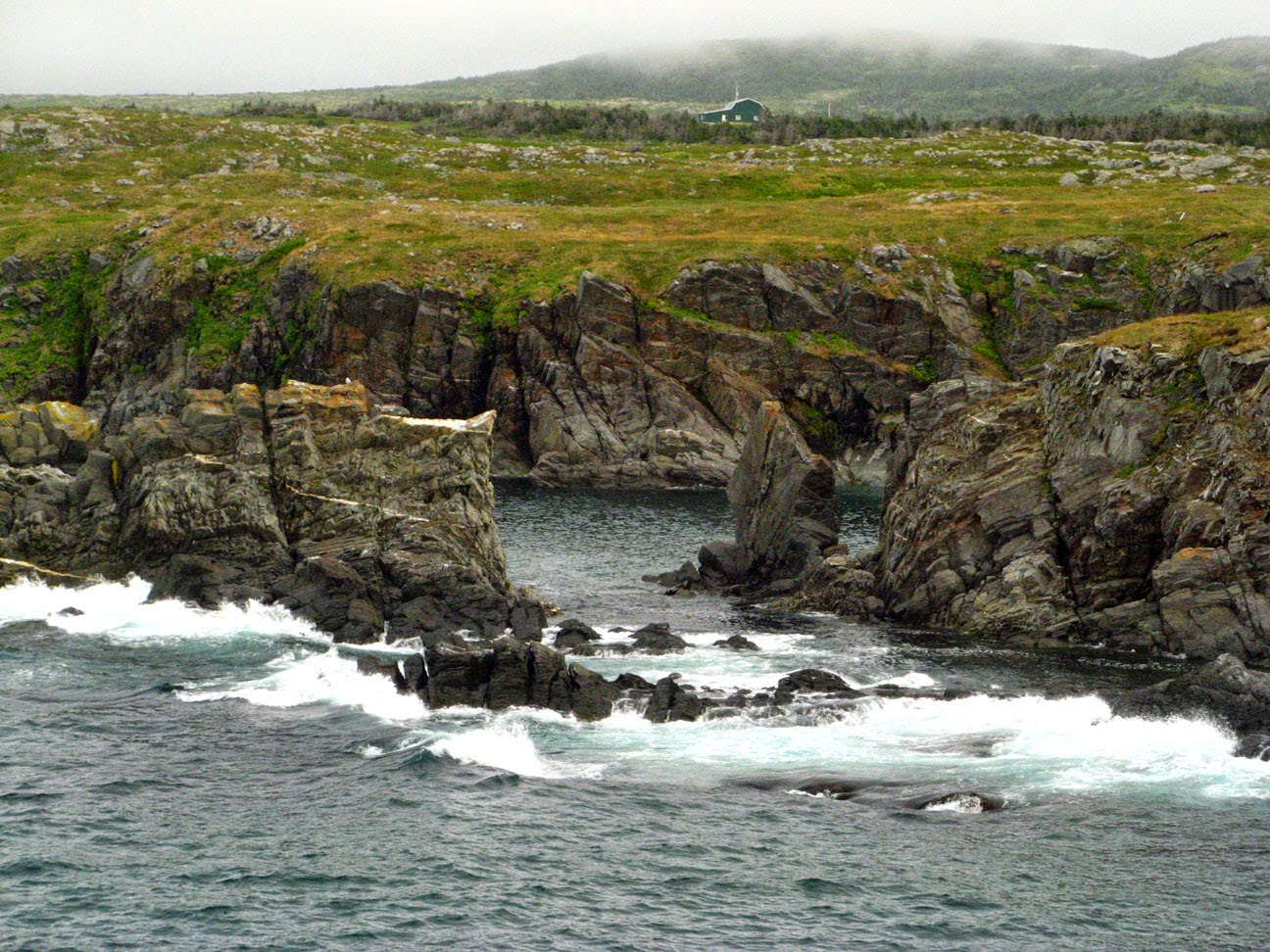.JPG) |
The rocky coastline
|
The
second time we went for lunch at Neil's Yard, we discovered it was part of the Mockbeggar Plantation. We visited the
main 19th century house first, before lunch. No one is sure where the name “Mockbeggar"
came from, but various communities of that name are found in England, in
Hampshire, Essex and Kent. It had a succession of owners, and may be the oldest
identifiable fishery plantation in Newfoundland. The salt box store was built
in 1733, It has been a salt fish store,
salmon packing house, salt store, fish dryer, barter shop, temporary residence
and temporary Methodist Church in1871, headquarters for the Salvation Army
Corps in 1886, and miscellaneous warehousing in recent years. The residence was
built for Jabez Saint in 1872-73. From 1939 to 1966, the property was occupied
by Gordon Bradley, a lawyer and politician, who played a significant role in
bringing Newfoundland into Confederation with Canada, then served as
Newfoundland's representative in the Canadian Cabinet and later in the Senate.
In 1980, the Bradley family donated the property to the Province. It has been restored
to the late 19th Century, including the beautiful library with the marble
fireplace that Bradley had in his Ottawa office.
There
was one last place we wanted to see, Trinity. It was once a bustling trade
centre, with shops and stages lining the shore and ships filling the harbour. Many
people now have summer residences in this delightful little town.
 |
Trinity from the Information Center
|
Much of the
town has been preserved, and has a number of historic points of interest owned
and operated by the historical society.
 |
The Parish Hall
|
Unfortunately we missed the New Founde Lande Pageant, an historical
jaunt through town with professional actors of the Rising Tide Theatre, who
enact scenes around town depicting Trinity’s early years.
However, with the aid of the folks at the Information Centre
 |
The Information Centre
|
and guides in each
building, we were able to wander through the town and get a sense of its
history. The Information Centre is set up with an overview of the town and its
history. The Georgian style Lester-Garland
House,
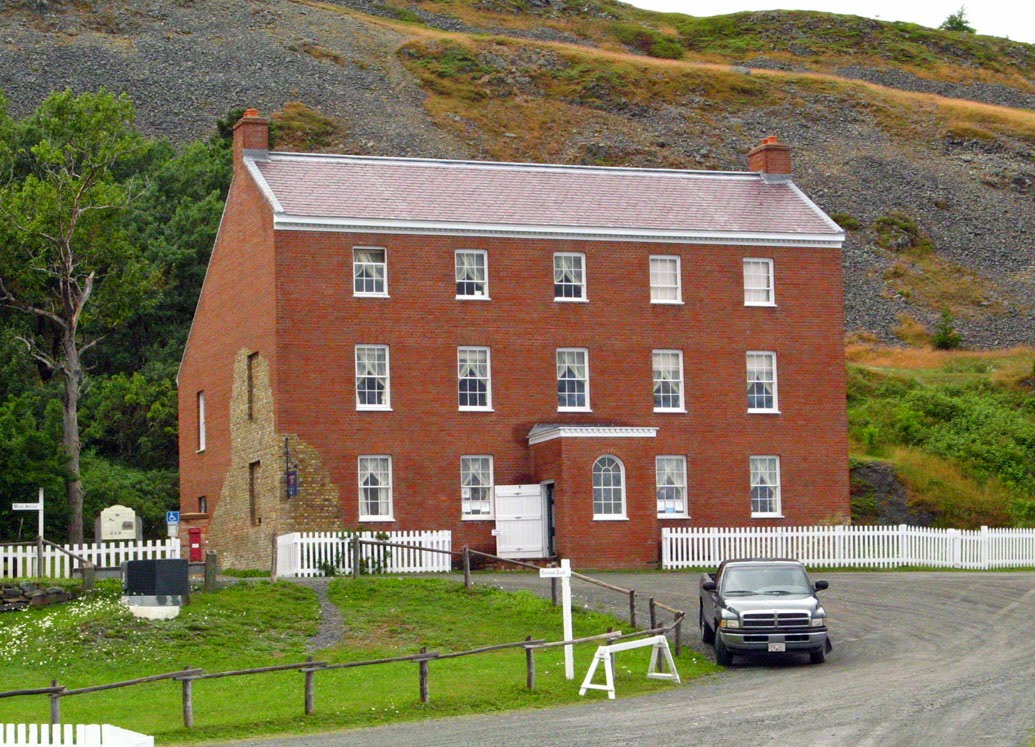 |
The stone on the left front is from the original building
|
the first of its kind in the province, was reconstructed in 1996 to
the detail of the house in 1819. It was built for the mercantile families of
the Lesters and Garlands. The house was taken down in the 1960’s
and rebuilt by the Trinity trusts in England and Canada. There was a collection
of furniture being stored in the house. Our guide informed us they were having
an “action” the following
week. It took us a while, but we finally realized she was telling us about an “auction”. The Mercantile
Premises are what is left of the many stores. Fish merchants operated on a credit
system of trade. Goods and supplies were advanced at the beginning of the
fishing season. Fishermen delivered their products of fish, oil and other
staples. Accounts were settled in the fall and families typically took more
goods to last them over the winter. This was called the “credit
or truck system”. The Green Family
Forge
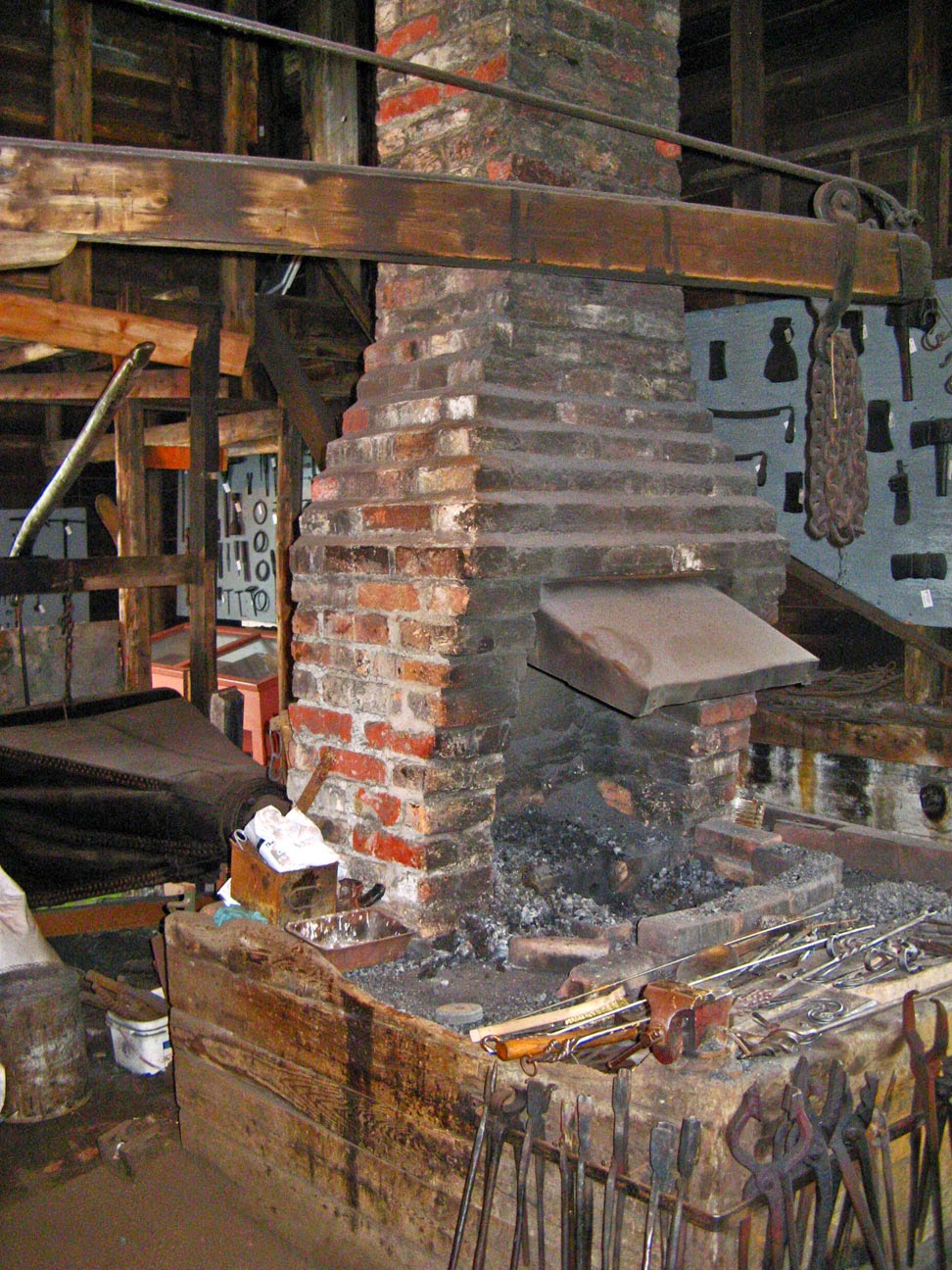 |
One of the two forges. Look at the size of the bellows
|
was worked by the Green Family from 1750’s
to 1955. This building was donated including a collection of tools used by the
family for six generations. Here horseshoes, anchors and iron products for the
fishery and the home were made and repaired. Trinity Museum is housed in a salt
box style building, containing a collection of over 2000 artifacts donated by
the people of Trinity.
Emma Hiscock moved to her new house as a bride, and was
left a widow few years later with six children to support.
 |
Emma's Bedroom
|
She became a
shopkeeper, post mistress and landlady. We wandered further down the street to St.
Paul’s Anglican Church.
 |
St. Paul's Anglican Church
|
This is gothic revival style, built in
1892. Its records of baptisms, marriages and burials are the oldest in the
province, dating back to 1753.
 |
Windows at the back of the church over the door
|
We then decided to follow the road around to the
lighthouse.
 |
Looking up at the lighthouse inside the Fort
|
It became a single track, very rough road, going up and around the hills.
From here we got a beautiful view of the
town of Trinity, and the harbours.
 |
Trinity from across the bay
|

|
A wonderful Restaurant for lunch
|
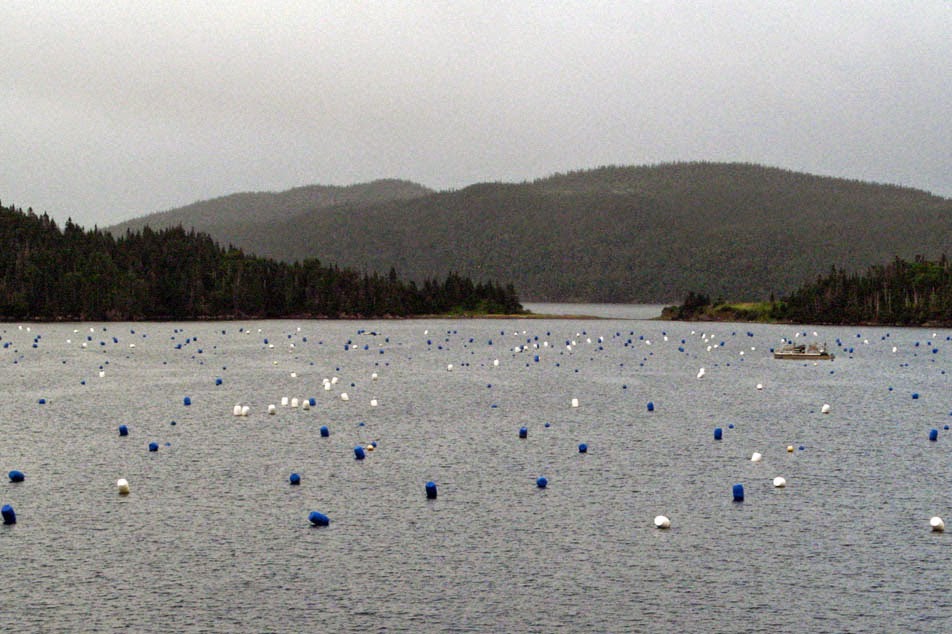 |
Mussel Bed on the way out of Trinity
|
Even though it poured rain most of day, an
umbrella and a rain jacket kept us reasonably dry.
We
had planned to go down the Burin Peninsula and take a trip to St. Pierre and
Michelon. However, we met a couple who had just taken the trip. The Ferry ride
for them was $180 return, they could only see St. Pierre, the small island, everything
closed from 12 to 2, and the ferry back was 3:30pm. They stayed the night at a
cost of 150 euros or over $200. [There is only one day a week that you can go
over and back in one day.] All in all, with the cost and the rainy weather, we
decided to forgo the jaunt.
So
the next stop is St. John’s. Note the absence of blue skies...





